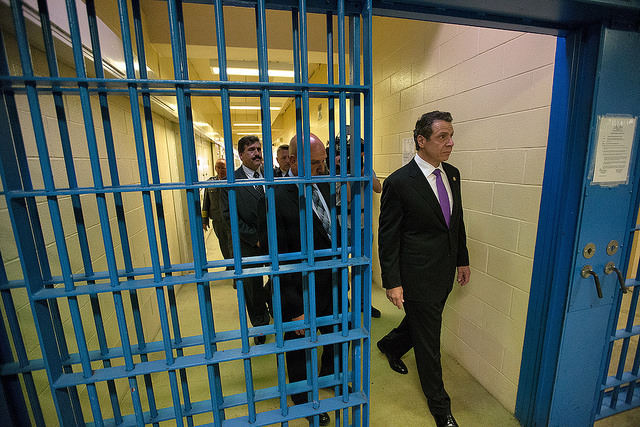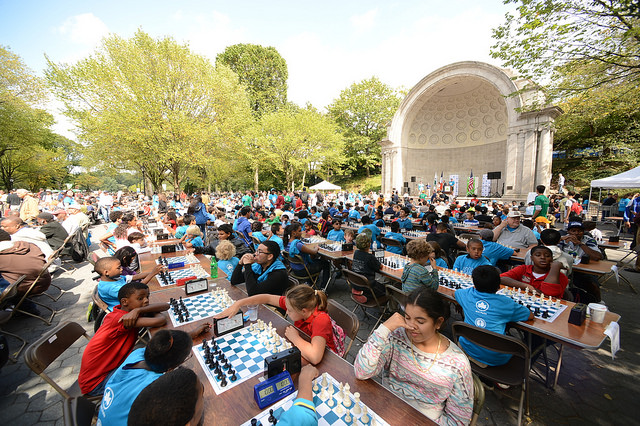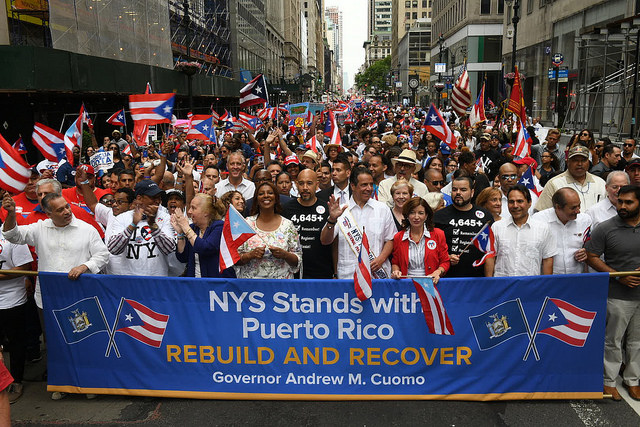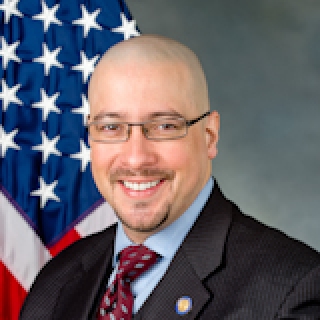For Justice and Decarceration, Enact Second-Look Sentencing

(photo via the Governor's Office)
Regardless what one thinks of presidential pardons, we should reflect upon a simple truth – convictions and sentences meted out at one point might not be appropriate decades later. That is especially true for many people currently serving life or massive prison sentences.
Many have argued for sentence commutations for specific classifications of people. In recent years, the Supreme Court has recognized that judges sentencing young people, even for violent crimes, must consider lack of maturity, impulsivity, and the inherent potential for change, and so reformers are asking courts to resentence those serving long prison terms for crimes committed when they were young. Many people advocate for medical parole or compassionate release for the elderly and infirm. Others focus on people deemed to be low-level, non-violent drug offenders.
At the heart of the problem, however, are all the people serving draconian sentences for crimes committed when they were adults and who are not, at least not yet, suffering from any debilitating illness or in any other “special” category. In fact, it is the “normalcy” of so many cases that highlights the issue we must confront.
Consider Jawad Musa. He is 53. He has been incarcerated for 27 years. A confidential informant and an undercover orchestrated what is known as a reverse sting. Mr. Musa and several others received a phone call saying there was heroin for sale if they could muster $20,000. They cobbled together the money, drove to New York, met the undercover, showed the cash, and were arrested – no drugs were ever exchanged.
Mr. Musa was convicted at trial. The judge who sentenced him expressed frustration with the mandatory sentence he had to impose and wrote that “the length of [Mr. Musa’s] sentence and time served thereon makes him an appropriate applicant for executive clemency.” The trial prosecutor who went on to serve in high level positions in the Justice Department, as well as being named Assistant Attorney General for National Security, wrote that “justice has been done for Mr. Musa’s drug crime in 1991” and “mercy and fairness now dictate that he be given the opportunity to rejoin society and enjoy the balance of his life as a free man.” The Captain at his federal penitentiary wrote that Musa is a “positive force, mentoring younger prisoners” and “I am confident that if granted clemency Jawad would quickly become a productive member of society. He has served a sufficiently long sentence and deserves the chance to re-unite with his family.”
And yet Jawad Musa remains in prison – for life.
Consider Roy Bolus. He is 48. He has been incarcerated 30 years. Unlike Musa, Roy participated in a violent and horrific crime. But unlike Jawad, Roy was only a teenager – he was 18 years old and had never been convicted of any crime. Roy and five other men, including two other teenagers, went to Albany, New York to steal a safe from a rival drug dealer. Once they got inside, one of Roy’s co-defendants shot and killed two people. Roy was in another room at the time of the shooting, did not have a weapon, never fired any shots, but was convicted of felony murder.
Roy’s extraordinary achievements while incarcerated for the past three decades are matched only by the outpouring of support he has garnered for clemency. He has attained Associates, Bachelors, and Masters Degrees and is pursuing a Doctorate. He has taught more than 5,000 hours of classes on HIV prevention, self-improvement, and a variety of academic subjects. He has been the Chair or President of several organizations and helped build an educational program inside the prison. He has numerous letters from family and friends who offer housing, employment, love, and support. Several men write compellingly of the impact Roy had on their determination to persevere while in prison and to thrive if they ever made it to the outside.
And yet it really doesn’t matter. Roy was sentenced to 80 years to life in prison. He is scheduled to see the Parole Board in 2067. He would be 98 years old.
There are countless other similar stories that are part and parcel of the epidemic of mass incarceration – people who have committed crimes, including brutally serious ones, but after decades in prison have grown into remarkably different people.
Last year, the venerable American Law Institute, a non-governmental organization of judges, lawyers and academics, approved the first-ever revisions to the historic Model Penal Code. The MPC, taught in virtually every law school, was developed in 1962 to introduce uniformity and coherence to the myriad criminal codes in the 50 states, and serves as a model across the country. The update to the Code took more than 15 years to complete and yielded a comprehensive 700-page report.
The ALI focused specifically on sentencing in order to address the decades of punitiveness that led to the current state of mass incarceration, made all the more shameful by the significant racial disparities in American jails and prisons.
One recommendation in particular addresses the epidemic of 2.2 million people behind bars. The Code now calls for state legislatures to enact a “second look” provision; to create a mechanism to reexamine a person’s sentence after 15 years no matter the crime of conviction or how long the original sentence. If the original sentence remains unchanged, it would be revisited every ten years thereafter.
While many will sound the alarm for “truth-in-sentencing” or the need for finality, the second-look provision asks a very basic question -- are the purposes of sentencing better served by a sentence modification or by adhering to the original sentence imposed many years earlier?
The commentary to the Code cites a host of utilitarian reasons why long sentences should not be frozen in time, suggesting that “governments should be especially cautious” and act with “a profound sense of humility” when depriving people of their freedom for most of their adult lives.
The commentary notes further that new developments might show that old sentences are no longer empirically valid, as current risk assessment methods claim to be better at predicting risk of recidivism than those previously used. Similarly, new rehabilitative approaches might be discovered for people who at the time of their sentencing were thought resistant to change.
The second-look provision is bold and unprecedented – to actually redress the past 50 years of mass incarceration requires nothing less, as most proposed criminal justice solutions and reforms are prospective and have no impact on those people currently in prison. Further, executive clemency in the form of sentence commutation has also proven to be of limited utility as Presidents and Governors are loath to exercise this power to any serious and meaningful degree.
Second-look allows for mid-course correction if warranted by some measure of changed circumstances -- major changes in the offender, his family situation, the crime victim, or the community -- that merit a different sentence. It is consistent with the growth of restorative justice that seeks to move away from the punishment paradigm of the last several decades. Second-look also allows the sentencing determination to be made in a calmer atmosphere than existed at the time of the original sentencing, so that any notoriety, outside pressure, or inflamed passions may have abated.
Bills have been introduced in the New York State Legislature regarding parole eligibility for people who are least 55 years old and have served at least 15 years of their sentence, and while the devil may be in the details, they are not insurmountable. There will be costs associated with establishing second-look processes but money will ultimately be saved as more people are sent home. Releasing people from prison is often controversial and even one crime committed by a releasee can threaten to shut down any second-look process, so there must be carefully constructed guidelines, created by myriad stakeholders, to ensure the independence of the decision-makers, and that all decisions are consistent, defensible, and transparent.
Mass incarceration is not just about unnecessarily incarcerating masses of people. It is about unnecessarily keeping masses of people in prison for decades. A sentence once imposed is not thereby automatically rendered, just, fair and appropriate in perpetuity. Ultimately, second-look mechanisms are meant to recognize and value the possibility of change and transformation, and to intervene when drastically long sentences are indefensible.
***
Steven Zeidman is a professor of law at CUNY School of Law. He is on Twitter @SteveZeidman. (For related bills in the New York State Legislature see S.8581/A.6354A; S.8346/A.7546.)
***
Have an op-ed idea or submission for Gotham Gazette? Email This email address is being protected from spambots. You need JavaScript enabled to view it.
Revitalizing New York’s Aging Parks

(photo: Parks Department)
New Yorkers are all too familiar with the consequences of aging urban infrastructure. Years of underinvestment in New York City’s century-old subway system has led to a full-blown transit crisis, with rampant delays, consistently overcrowded trains, and frequent equipment breakdowns.
But the subways are just the most glaring problem in an aging city. Another vital piece of public infrastructure is also several decades old, years behind on basic maintenance, and nearing a breaking point: New York City’s parks system.
With more than 100 million parks visitors each year and the city’s population at a record high, New York’s 1,700 public parks have never been busier. These open spaces provide a communal backyard to millions, with major benefits for health and happiness in every corner of the city. But the combination of advanced age, record usage, and decades of underinvestment in maintenance and infrastructure means that serious cracks are showing.
The average city park is 73 years old, and parks in every borough are struggling with aging assets that are at or near the end of their useful lives—including drainage systems, retaining walls, and bridges. About 40 percent of pools and almost half of the 53 recreation centers in city parks were built before 1950. The waterfront facilities overseen by the Parks Department—148 miles of coastline, including beaches, marinas, piers, and docks—are on average 76 years old.
Yet one in five parks has not had a major infrastructure upgrade in 25 years, according to a new report from the Center for an Urban Future. At least 46 parks, triangles, and plazas have not received significant capital investment in nearly a century.
In many cases, the results are plain to see. Serious flooding, damaged pathways, missing stairs, out-of-order bathrooms, and neglected horticulture are common problems in parks across all five boroughs. Other times, the infrastructure issues are hidden from view. For example, numerous drainage systems in city parks still rely on clay pipes from the mid-20th century. Most of the city’s thousands of park retaining walls are cracking and in need of repair or replacement. And one in five park bridges was found to be seriously deteriorated during its most recent inspection.
As maintenance and infrastructure needs soar, the city has struggled to keep pace. The Parks Department’s state-of-good-repair needs jumped 45 percent over the past decade, from $405.9 million in 2007 to $589.1 million last year. Meanwhile, recommended maintenance needs more than doubled, from $14 million to $34 million. But fewer than 15 percent of these needs were funded in the city’s most recent budget—among the lowest levels of any agency.
Although age is the major culprit contributing to mounting infrastructure needs, decades of underinvestment in basic maintenance has taken a toll. The Parks Department has too few full-time staff—including plumbers, masons, and gardeners—to keep parks assets in good shape and mitigate problems before they grow. New York’s system has about 150 gardeners citywide for roughly 20,000 acres of parkland—a ratio of 1 gardener to every 133 acres. By comparison, San Francisco employs over 200 gardeners for 4,113 acres of parkland—a ratio of 1 to 20.
Mayor Bill de Blasio and the City Council deserve credit for taking important steps to address parks infrastructure needs. In recent years, the Community Parks Initiative and Anchor Parks Initiative have dedicated more than $300 million to improve chronically underfunded parks, with significant benefits in every borough. But there’s still much more work to do to shore up the city’s aging parks system and lay the foundation for the next century of public open space.
It starts with committing to strategic increases in the Parks Department’s expense budget, with the goal of permanently funding much-needed skilled maintenance staff such as gardeners and foresters, masons, plumbers, electricians, mechanics, and other skilled workers, while closing the maintenance gap. In addition, the mayor and the City Council should establish a dedicated pool of capital funds for the parks system’s unsexy infrastructure—such as drainage systems and retaining walls—which are often passed over in discretionary funding.
To pay for all this, New York City should explore new revenue streams dedicated to parks maintenance and unglamorous capital projects. For example, a small surcharge on tickets to sporting events and greens fees at city golf courses could fund routine maintenance at parks, playgrounds, and recreation centers. Likewise, a surcharge on dockage fees at city-owned marinas could be used to maintain waterfront facilities. There are also numerous parks where the city could add a reasonable number of concessions that enhance the experience of parkgoers while providing vital new sources of revenue.
Given the scale of the parks system’s needs, the city’s capital dollars need to stretch as far as possible. But today, that’s hardly the case. A single bathroom can cost upward of $3 million and ten-year renovations are not uncommon. The mayor should make reforming the broken capital construction process a top priority, and the Parks Department should work to significantly speed up each phase of the process under its control.
New York’s public parks have benefited countless New Yorkers for well over a century. By investing wisely in their revitalization, these essential open spaces can continue to thrive into the next century and beyond.
***
Eli Dvorkin is managing editor of the Center for an Urban Future, a New York–based think tank focused on expanding economic opportunity. On Twitter @nycfuture & @wetwax.
***
Have an op-ed idea or submission for Gotham Gazette? Email This email address is being protected from spambots. You need JavaScript enabled to view it.
Without the Federal Government But With New York, Puerto Rico Endures

(photo via the Governor's office)
Loíza is a town on the northeastern coast of Puerto Rico, home to almost 30,000 American citizens. For 72 hours last September, as Hurricane Maria ravaged the island and other territories in the Caribbean, Loíza and all of its residents became isolated from the outside world when the three main roads that connect this medium-sized town to the rest of the island became impassable.
The challenges that residents of Loíza faced and continue to deal with are not only emblematic of the lack of resources invested in rebuilding efforts and the crumbling economy hindering the island's recovery, but also of the resilience and resourcefulness of the Puerto Rican people.
Last March, I returned to my native Puerto Rico to see the impact of the disaster firsthand. I visited six different towns across the island, including Loíza, and with a great deal of frustration and heartbreak, I confirmed what I had feared: the inadequate and anemic responses from the federal government and the island’s central administration have left almost 3 million Puerto Ricans on the island and their local governments to fend for themselves.
Thousands, especially those in low-income communities, continue to suffer from unreliable electricity and water systems, food and resource shortages, and serious mental and physical health emergencies. Considering this, it should come as no surprise that the real number of storm-related fatalities is closer to 4,600 souls, according to a recent Harvard University report, as opposed to the 64 official deaths counted by the U.S. government.
While the trip was disheartening in many ways, it was also inspiring and hopeful. I met several mayors, nonprofit organizations, scholars, labor leaders, and dedicated individuals whose steadfast leadership in helping Puerto Rico recover has been nothing short of heroic. Together, they have slowly built an important grassroots recovery movement that has made significant progress despite minimal resources.
For instance, Taller Salud, a Loíza-based nonprofit organization seeking to ensure the physical and emotional well-being of low-income women and girls, saw its mission transform out of necessity, becoming a critical emergency response provider giving out life-saving assistance to thousands.
To put it plainly, Puerto Ricans do not need or want charity. What they need is our support to further invest in those leaders and communities working tirelessly to implement innovative visions and projects locally. They want to maintain full agency over how their hometowns and infrastructure are rebuilt. We do not need to tell them or show them how to survive or thrive -- what we need to do is augment their ability to do what they have already been doing.
Many states and cities across the mainland United States have stepped up to provide support in the face of the failed response by our federal government. I am proud to say that New York has done this and in spades.
Our State and City governments, along with elected officials across all levels of government, local nonprofit organizations, civic leaders, and many New Yorkers launched an extremely dynamic relief effort, which continues to this day. From millions of dollars in monetary donations, to collecting tons of essential items, to sending highly qualified emergency responders, medical staff, and expert personnel to help rebuild the island’s decayed infrastructure, New York has led by example as to how to coordinate a comprehensive relief response and empower the Puerto Rican people to take the lead in its recovery efforts.
During a recent meeting of Governor Cuomo’s New York Stands with Puerto Rico Rebuilding and Reconstructing Committee, I joined my fellow committee members and Governor Cuomo’s administration to identify a list of priorities and recommendations to help facilitate Puerto Rico’s rebuilding efforts.
 My list of recommendations focuses on counseling and mental health services, access to higher education, employment assistance, accessibility of clean water, and promotion of green energy infrastructure.
My list of recommendations focuses on counseling and mental health services, access to higher education, employment assistance, accessibility of clean water, and promotion of green energy infrastructure.
As a result of the recent committee meeting, I penned a letter with members of the Senate Democratic Conference urging SUNY and CUNY to extend their in-state tuition credit program. This program aims to ensure that Puerto Rican and U.S. Virgin Islands students who relocated to New York are able to continue their higher education for the next academic year. Last week, SUNY extended the program and CUNY is expected to do the same imminently.
Puerto Ricans have not only seen their lives completely torn apart by a natural disaster, but also by the criminal inaction of our federal government. While the road to recovery will be long and filled with challenges, the spirit of my fellow Boricuas remains intact. At a time of such darkness, the clarity of their ideas and their commitment to rebuilding is worthy of support. The goal of the diaspora, and all who seek to help, must be to empower our Puerto Rican brothers and sisters to transform and improve their neighborhoods and towns as they see fit. The storm and this administration have dealt a painful blow to Puerto Rico, but the island and Puerto Ricans endure.
***
Gustavo Rivera is a state senator representing part of the Bronx and a native of Puerto Rico. On Twitter @NYSenatorRivera.
***
Have an op-ed idea or submission for Gotham Gazette? Email This email address is being protected from spambots. You need JavaScript enabled to view it.




